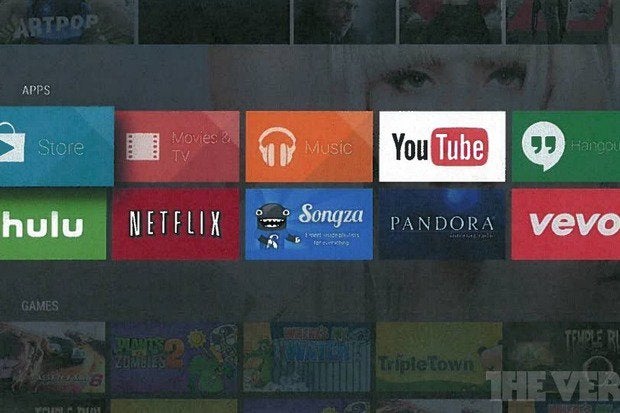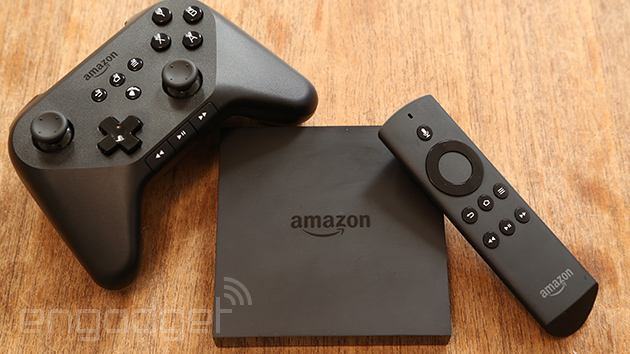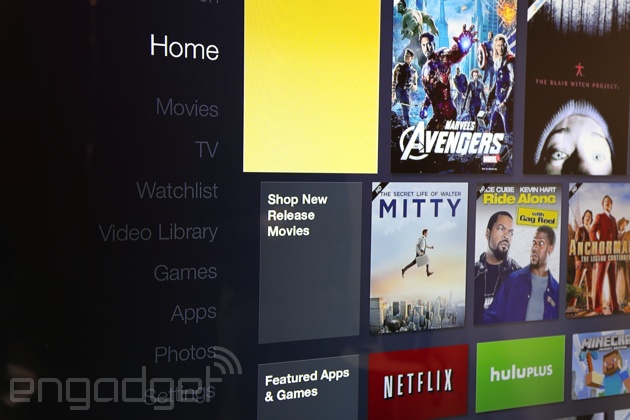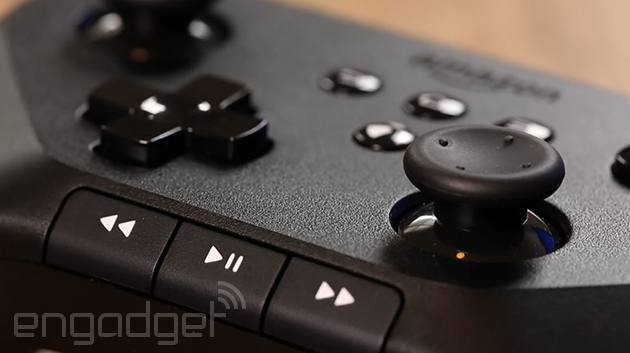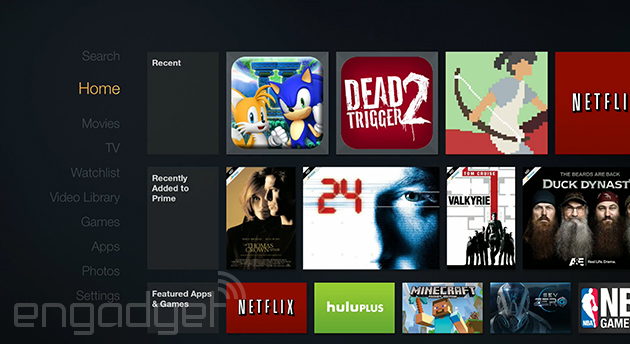Here's the thing about Amazon: We can't figure the company out half the time. Few things embody that quite as well as the Fire TV.
The company is adamant that the set-top box is not a gaming console,
but it's invested heavily in original game development for it and even
produced a shockingly good gamepad accessory. Still, video games are
just a "bonus." One of the pillars of the streaming-media box is
supposed to be openness, but there's no denying that other services like
Netflix are treated like second-class citizens here. They're invited to
the party; they just better not outshine the host.
The Fire TV
may be the next step for Amazon as it tries to build its own ecosystem,
but it's also yet another entry in the crowded streaming-media market.
And the big question is: Do we need another? We've got TV set-tops for
cable, satellite and fiber (at one time joined by a disc player for
movies and maybe a game system or two). The next-gen game consoles do
double duty as entertainment hubs, and there's no shortage of cheap
boxes designed specifically to stream Netflix, HBO Go and Pandora. Add
in smart TVs and the rise of pint-sized dongles, and the question of
what to watch becomes
how to watch. The Fire TV
is trying to muscle out competitors with its $99 price and a strong
focus on performance, search and openness. Now that we've spent a few
days living with one, we can judge whether it's just another option
among many, or truly a standout that finally fixes problems the others
have so far ignored.
Amazon Fire TV hardware
See all photos
9 Photos
Amazon Fire TV UI
See all photos
41 Photos
Hardware
The Fire TV is the very definition of understated design.
It's a simple matte black box with a small Amazon logo etched in the
top and single white LED on the front to tell you when it's powered on.
There are no purple cloth tags (like on the Roku) and the company didn't
bother with embellishments like rounded corners. Even around back,
there's a minimal selection of ports; just HDMI, Ethernet and optical
audio jacks, plus a currently useless USB socket. The result is perhaps
the most attractive and unobtrusive streaming set-top box we've seen
yet. While its overall footprint is larger than the Apple TV's, it's
still only 0.7 inches tall, which means it's nearly invisible from 10
feet away. Besides, the remote uses Bluetooth instead of IR, so you can
hide it anywhere you want.
Not that you're going to be picking it up terribly often, but Amazon's
box is actually quite heavy -- a dense block made from plastic, aluminum
and silicon. Most of the internal space is taken up by a giant heatsink,
an essential concession given the rather high-powered internals. The
1.7GHz quad-core Snapdragon processor, along with the Adreno 320 GPU, is
far more powerful than anything found in other streaming devices and it
shows. Searches and even browsing the UI are noticeably faster on the
Fire TV than on a Roku or Apple TV. And we haven't even mentioned what
it's capable of on the gaming front, but let's not get ahead of
ourselves.

Amazon also more or less nailed the remote's design. It's just the
right size with a shallow, but comfortable groove for your finger
underside. The buttons have little travel, but do produce a satisfying
click when pressed. The remote does still bear the marks of Fire TV's
Android roots. Below the thin ring that serves as a directional pad are
six buttons aligned in rows of three -- the top row features your
old-school Android back, home and menu keys. There are two minor, but
irksome, issues here. For one, the menu key is largely useless except
from within certain apps (more on that later) and it would feel more
natural if the media controls were directly below the directional pad
and select button. This not only led to occasionally hitting the menu
button when I was looking for fast-forward, but it also sends a subtle
message to the user about the priority of the controls. If Amazon was
indeed building a media-first device, then the media controls should
have taken precedence -- and thus had better placement -- on the remote.
The most important key on the remote, though, is the search button.
Amazon wants this to be the primary way you interact with the UI and
indeed, the voice search here is both easy to use and insanely fast.
Simply press and hold the microphone key, which is separated from the
rest of the buttons, and speak into the mic built into the Bluetooth
controller. More often than not within a second or two you've got your
results, and there's no need to breakout a special remote app on your
phone.
Software
The Fire TV is, as you'd expect, running a heavily tweaked version of
Fire OS, which is itself a heavily tweaked version of Android. It's not
surprising then that there are some seams showing around the edges of
this young platform. Still, Amazon does deserve credit for stitching
together a UI that's smooth, polished and (mostly) intuitive. The layout
should be immediately familiar to anyone who has used a Kindle Fire
before -- the home screen is populated with movies, TV shows and apps
arranged in the form of large, easy-to-read icons and there's a heavy
dose of side-scrolling carousels. On the left are the various top-level
distinctions (games, search, movies, et cetera), while the right is
reserved for various sublists, such as "recently used" and "featured."
It's not the cleanest or simplest design we've ever seen, (Apple or Roku
definitely hold that title), but even your Luddite parents should be
able to find their way around.
Amazon Fire TV UI
See all photos
30 Photos
Once it's plugged in and connected, the Fire TV presents a short (and
apparently unskippable) demo video to make sure you're familiar with
its features. A number of other help videos are also located under the
settings menus, and if there's still a problem, requesting a support
phone call from an Amazon rep is just a button press away. It's not
quite as easy as the Kindle Fire HDX's Mayday button, but it should mean
you could gift one of these to a relative without worrying if they'd
actually be able to use it. The focus here is on making sure anyone can
get it running, and if they get addicted to Amazon's growing suite of
services, then all the better.
The problems start, though, once you start to dig a little deeper into
the interface. Fire TV sticks with the carousel layout found on Amazon's
tablets. That's fine for perusing short lists, like the top 10 movies
on Prime, but when you're looking at broader categories it can become
quite cumbersome. Scrolling through the entire list of available action
movies on Amazon can take a couple of minutes, even if you're just
holding down the right button and not bothering to read. To make matters
worse, there appears to be no rhyme or reason to the order of these
lists. And when you reach the end, it doesn't automatically cycle back
to the beginning.
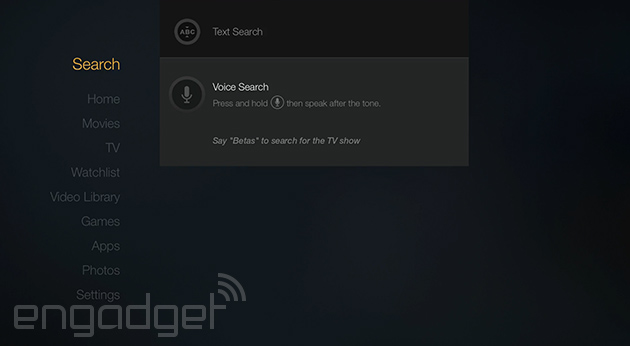
The best way to track down the content you want is search. First the
good: Amazon has created a voice search that's both fast and accurate.
Now for the bad: You can't use your voice to search other content
sources besides Amazon. It does offer "quick" links to videos on Hulu,
but by default, it tries to push you to purchase or rent titles through
Instant Video. To find out if you can watch it for free through your
Hulu Plus subscription, you'll have to click through the "more ways to
watch" option. If you try to press the voice search button from within
the Netflix app, you're kicked back out to the home screen, where can
only search through Amazon's library.
Things get even worse if you decide not to use voice search. For
instance, if you navigate to the search tab on the left, you'll still
have to click up to access text search since it defaults to voice. And,
while Amazon was quick to mock others for their archaic text-entry
methods, the Fire TV's keyboard is even more offensive. You're offered a
string of letters from A to Z in that all-too-familiar carousel view,
which you'll have to scroll through and punch letters in one at a time.
And, again, you can't scroll past the end to return to "A." That means
when searching for something like
La Dolce Vita or
La Jetée, you have to scroll from the first letter of the alphabet to the last option on the keyboard, which is a space. And you'll
have to do that since voice search has a tendency to trip over foreign language titles, and especially the word "la."
The killer feature, though, is supposed to be ASAP, short for
Advanced Stream And Prediction. The idea is that it's designed to
predict what you're going to watch and start preloading it in the
background (so long as the source is Amazon itself). If you hover over a
title while browsing for a period of time or click through to the
information page for a movie, ASAP is supposed to start downloading the
content in the background. In demos, that meant when you pressed play,
your video started playing instantly -- no buffering or loading screen.
It's even supposed to preload the next episode of TV shows you're
working through. In real use, however, the feature never quite lived up
to its promise. It should get better with time, but we still saw loading
screens more often than not. And the wait was noticeably longer over
WiFi than it was using a wired Ethernet connection.
Apps and content
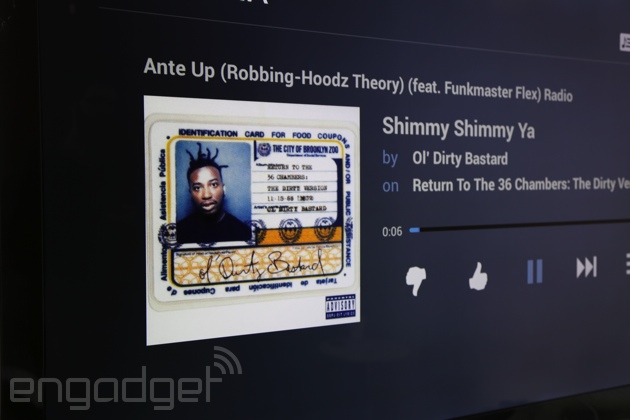
Right out of the gate, Amazon is offering support for most of the
major video streaming services. We're talking Netflix, Hulu Plus,
YouTube, Showtime Anytime, Watch ESPN and Crackle -- all the biggies are
there. And when it comes to music, you've got access to Pandora and
iHeartRadio. Of course, while Fire TV is technically an open
platform, Amazon really wants you to use its library. And, so long as
you're comfortable paying Amazon's prices, that's not a big deal. There
are countless movies and TV shows available through Instant Videos.
Stumping Amazon isn't impossible, but it's definitely tougher than
finding holes in the Netflix, Hulu or Google Play collections. Of
course, not all of the movies and TV shows on Amazon are available for
free through a Prime subscription. In fact, the vast majority aren't,
and there's no way to filter out the things you need to pay for. While
Amazon is preloading the Fire TV with content you've purchased and
photos you've uploaded to Cloud Drive, there is one glaring omission -- there's currently no support for music or Cloud Player.
It's definitely a good thing for Amazon and its customers that
players like Hulu and Netflix are on board, but there are certainly some
issues on the app front. For one, most of the offerings are badly done
ports of Google TV apps.
They're not well-maintained and still retain elements of their
respective UIs that were designed for devices with keyboards. YouTube in
particular still displays prompts for keyboard shortcuts on the screen.
Pandora has a nice feature in that it pops up notifications, but it has
a strange tendency to start playing even after being stopped. For
instance, after listening to a Black Sabbath station during a session of
the game
Sev Zero, we decided to back out and watch an episode of
Invader Zim.
When the show was over, we spent a few minutes poking around the menus
and then walked away. The Fire TV eventually went to sleep. But when we
woke it up the next morning, it instantly picked back up in the middle
of "The Wind Cries Mary." This weird behavior extends beyond the
questionably built apps. More than once, the Fire TV froze up,
displaying a blank screen before eventually crashing and kicking us back
out to the home screen after backing out of a movie.
Gaming
Fire TV's major one-up over the competition isn't power, voice search or the platform's openness: It's
games.
Apple TV, Roku and Chromecast don't offer much in the way of gaming
functionality. Meanwhile, the Fire TV even has its own (separately sold,
$40) gamepad. No, this isn't an Amazon game console, but
it's damn close.
Before addressing Fire TV's limitations when it comes to gaming -- of
which there are many -- allow us to be up-front here: It's a net
positive that Amazon's jumping into gaming. Not only is the company's
latest major hardware launch capable of playing games, but also Amazon's
got its own game-development department. Hell, Amazon even outright bought the studio that made the new
Killer Instinct game. The first game from Amazon Game Studios,
Sev Zero, was available at Fire TV's launch last week. It's fun, pretty and embodies "leading by example."
Sev Zero
is a medium-sized game that's enjoyed as both a casual dalliance and a
serious affair. It's the kind of title that Fire TV's game store
should be filled with. What we've found thus far is something else entirely.
General experience
That Fire TV runs a fork of Android is most apparent while browsing
the selection of games currently available. Regardless of Amazon's
categorical breakdown, the selection is easily described as, "an
abridged version of Android gaming's greatest hits." A smattering of
Sonic the Hedgehog titles,
Minecraft: Pocket Edition and -- of course --
Canabalt are all there, as well as newer hits like
Dead Trigger 2 and
Asphalt 8: Airborne. Of course, it's not just the selection that reeks of Android.
The other unifying theme is, ironically, inconsistency. Some games
look great and fit on TV without a hitch, while others cut off some UI
elements (and, ultimately, pieces of the game being played). It's clear
that many titles are rushed conversions from other platforms, something
that's evident whether it's the gamepad not doing anything beyond
standing in for a touchscreen or the game not displaying correctly.
There are only so many games to choose from at launch, but Amazon
Game Studios lead Mike Frazzini told us that "thousands" are expected by
next month. With just 8GB of storage, though, don't expect to amass a
huge library of digital games on Fire TV. With a handful of streaming
apps installed (Netflix, Hulu, YouTube, etc.), we hit a limit of eight
to 15 of Amazon's smallest and simplest games at any one time on our
box. Stuff like
Asphalt 8 and
Dead Trigger 2 come with prettier graphics, but they also come with hefty storage requirements (over 1GB for the former). Installing
Deus Ex: The Fall, Sev Zero and
The Cave was easily enough to eat up the available 5.5GB for apps and games.
Smaller, fixable issues are also in ready supply. Browsing for games
to buy is a mess (and only stands to get messier as the library grows);
it's easy to accidentally quit out of a game with voice search; and
there's no way to leave a game running should you take a break and watch
a few episodes of
Inside Amy Schumer.
Playing games
Structure and ecosystem aside, the good news is that playing games on
Fire TV can be pretty fantastic. Not every game has a demo, but many
are free (at least for a limited trial). And, of course, there's always
the standard paid option. If you're looking for exclusives, there's only
one so far (
Sev Zero), but many more are slated to arrive in the coming months.
So, which games should you buy? We suggest the following, and in this order:
- Sev Zero: Part third-person shooter, part tower-defense game (yes, seriously), Sev Zero is a terrible sell on paper. Give this one a chance: It's a great demonstration of Amazon Game Studios' talent and is a refreshing, Iron Brigade-esque
hybrid of two totally different genres. And hey, it's really fun! You
can switch between tower defense and third-person mode on the fly, which
makes Sev Zero a delightful balancing act as the difficulty ramps up.
- Asphalt 8: Airborne: This is the closest you'll get to Ridge Racer/Need for Speed on Fire TV, and it comes shockingly close. Asphalt 8's
first few levels cost nothing, and we doubt you'll blink an eye when
asked to pay $1 for more races. It's not our favorite way of buying a
game, but Asphalt 8 is too good to skip just on principle.
- Outland: There's no reason not to at least try Outland,
as it's another one that starts free and asks for money only when
you've already been hooked. This is one of the many one-button games,
and it's a gorgeously drawn version of the ubiquitous mobile genre that
is endless runners. It controls beautifully, which is important because Outland
requires reactionary puzzle solving (often under strict time
constraints). This one is perfect for both casual and hardcore alike, as
well as everyone in between.
- Rayman Fiesta Run: If you've never encountered Ubisoft's surreal platforming standard before, Rayman Fiesta Run is an endless-runner take on Rayman's
long-running formula. This game is another no-brainer, as it's quirky,
smart, hilarious and a joy to play. The level art is consistently
beautiful, and the music is always a pleasure.
- Minecraft: Pocket Edition: What can we say about Minecraft that hasn't already been said? There's nothing quite like it (at least on Fire TV, outside of maybe Terraria). The only real downside is its price (just under $10), but we'll forgive that -- just for being an excellent game.
There are lots of other great games available on Fire TV, but we've
only played so many thus far. Beware: There are also tons of
not-so-great games available. Should you be unsure, we'd suggest sites
like
Pocket Gamer and
Touch Arcade, as many of Fire TV's titles were previously mobile games.
Gamepad
Have you used an Xbox 360 gamepad? Good news: Fire TV's gamepad
is very, very similar. With the exception of a trio of Android-specific
controls and media-playback buttons (as well as a GameCircle button),
its composition is identical: offset analog sticks, two triggers, two
shoulder pads, a d-pad and four face buttons. The fit and feel aren't
quite as nice as Microsoft's forebear; Fire TV's gamepad feels like a
good third-party Xbox 360 controller, in so many words.
The battery life, courtesy of two AAs, has so far been good. After
several days of regular use, our first controller is still running its
first pair of batteries. At $40, though... maybe you have a spare
Bluetooth gamepad sitting around? We're told that "most" work, and you
could always plug in a wired Xbox 360 gamepad if you're sitting nearby.
The competition
Curiously, though it's one of the Fire TV's most direct competitors, Google TV is missing from Amazon's official
comparison list
(scroll a little past the halfway mark). While there are some good
reasons for that (there's no single product line or spec, and the Google
TV branding has been mostly abolished), Fire TV's Android underpinnings
are nonetheless quite obvious. One of the easiest comparisons is to the
Hisense Pulse/Pulse Pro
family of devices. The Pulse Pro unveiled at CES has similar, if
slightly lesser specs than Fire TV, with 1GB of RAM and 8GB of ROM
storage tied to a dual-core CPU. Like other Android-based TV products
we've seen, it also has voice search and a number of the same apps. The
existing Google TV environment has tried to toss in so many options and
integration with live TV that it's more complicated than the Fire TV,
and so far, it doesn't have a similar focus on performance. According to
rumors, though, Google TV's next iteration could feature similarly
streamlined menus and a focus on gaming -- plus a box from big G itself,
so watch out.
The Apple TV
also costs $99, but comes tied to an entirely different ecosystem.
Infuriatingly, too, it doesn't come with an HDMI cable in the box. The
difference here mostly depends on which platform you prefer. Recent
software updates have made frustrations like setting up a WiFi
connection as simple as touching an iPhone or iPad to the box -- no
cheesy onscreen menus needed. You can also stream over AirPlay, but
you'll of course need an iDevice to make that happen. Amazon's set-top
box also lets users "fling" content from a phone or tablet to the TV,
but right now, its ambitions go a bit further. As with Google, rumor has
it that Apple will focus more on gaming with its next hardware or
software update, so for now, the choice between these boxes is more a
decision between iTunes and Amazon Prime than anything else.
Meanwhile, one of our favorite media streamers, the $99 Roku 3,
is facing a heartier challenge than ever thanks to the Fire TV. In its
favor, the Roku is still dead-simple to use, and offers a content
selection that its rivals can't match. Even so, being caught on the
outside without its own content store and mobile hardware ecosystem for
support, it loses some of the media-sync features that Amazon, Google
and Apple can provide. It also doesn't have a gaming experience to match
the Fire TV, although how much that means depends on your personal
taste. Today, the improved performance of its latest generation and
generous suite of available services mean it's still generally the best
option, but there are caveats, and with another six to 12 months on
shelves, it will be interesting to see if the competition catches up.
Plus, if you don't want to spend $99, then the cheaper Roku options
provide an experience comparable to the others listed here and let you
leave a few Jacksons in your pocket.
Finally, Google's wonderful $35 Chromecast
dongle is by far the most accessible of the bunch. It's cheap, and the
list of media services it ties into -- Netflix, YouTube, Pandora and
Plex -- is growing longer by the day. Aside from that, an often
overlooked, feature is the Chromecast's inclusion of HDMI-CEC, which
means it can change the TV to its own input as soon as it's activated,
something Apple, Roku and Amazon don't do. Of course, being cheap does
have its downsides: there's no remote control, which could be a
dealbreaker for people who aren't already used to navigating their media
on a phone or tablet. It also doesn't have as many services available
right away, and the only gaming experiences we've seen so far have been
quite casual indeed. For $35, it does a ton, and doesn't need your cable
provider's permission to stream HBO Go. And for some people, that will
be more than enough.
Wrap-up
The Fire TV is a compelling proposition, so long as you're already
locked into the Amazon ecosystem. It's fast, powerful and priced in line
with its higher-end competition. The addition of a single game
controller for $40 gives access to gaming that doesn't take the place of
a console, but suits the need of generation raised on tablets and
smartphones. The relatively high controller price (compared to the box
itself) makes multiplayer a bit dodgy, so if you're looking for couch
co-op, that's something to think about. The preferential inclusion of
Amazon services is a bit of a hurdle too, but if you already have a
Kindle Fire and Prime subscription, it makes more sense.
As a general-purpose photo, video and music streamer, though, even features like ASAP and its high-powered processor aren't quite enough to separate Fire TV from the pack. It's a worthy option, but far from the best, and we'll need some time to see how well it's supported by games, apps and services to see if Amazon can become a serious hardware player in the living room. Version 2.0 will probably be where all our questions are answered.

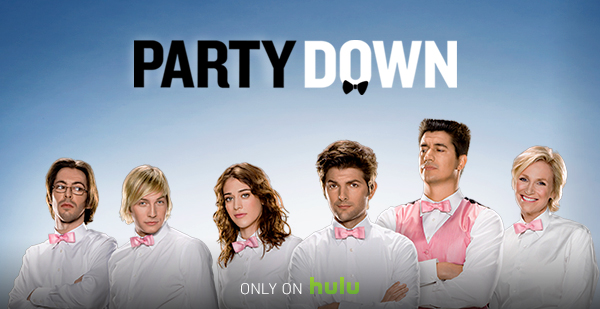
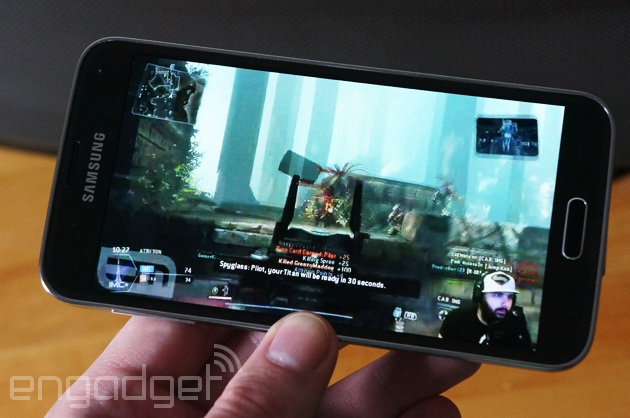
.JPG)
.JPG)
